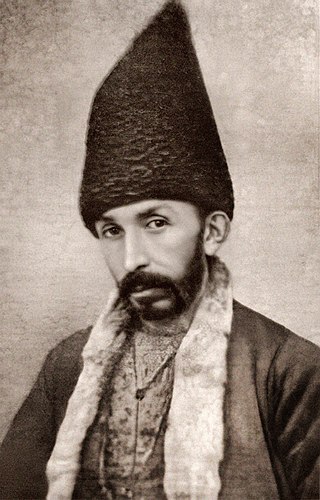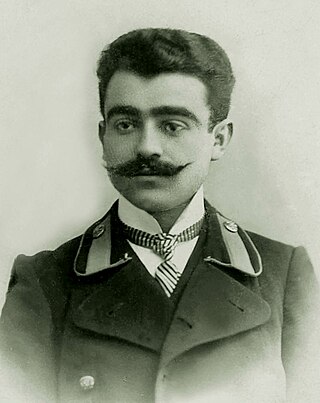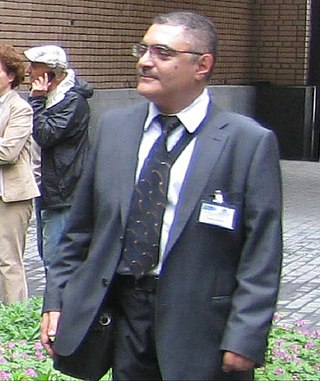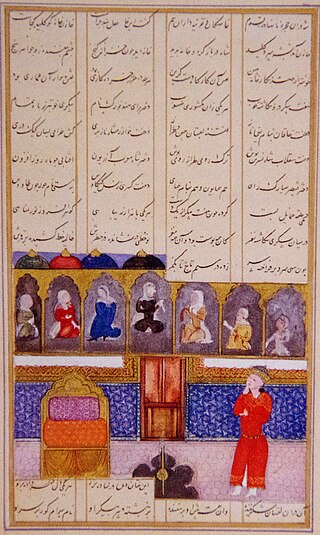Related Research Articles

Caucasian Albania is a modern exonym for a former state located in ancient times in the Caucasus, mostly in what is now Azerbaijan. The modern endonyms for the area are Aghwank and Aluank, among the Udi people, who regard themselves as descended from the inhabitants of Caucasian Albania. However, its original endonym is unknown.

Azerbaijani literature is written in Azerbaijani, a Turkic language, which is the official state language of the Republic of Azerbaijan, where the North Azerbaijani variety is spoken. It is also natively spoken in Iran, where the South Azerbaijani variety is used, and is particularly spoken in the northwestern historic region of Azerbaijan. Azerbaijani is also spoken natively in Russia, Georgia and Turkey. While the majority of Azerbaijani people live in Iran, modern Azerbaijani literature is overwhelmingly produced in the Republic of Azerbaijan, where the language has official status. Three scripts are used for writing the language: Azerbaijani Latin script in the Republic of Azerbaijan, Arabic script in Iran and Cyrillic script formerly used in Soviet Azerbaijan.

The Jewish Neo-Aramaic dialect of Urmia, a dialect of Northeastern Neo-Aramaic, was originally spoken by Jews in Urmia and surrounding areas of Iranian Azerbaijan from Salmas to Solduz and into what is now Yüksekova, Hakkâri and Başkale, Van Province in eastern Turkey. Most speakers now live in Israel.

Kurban Said is the pseudonym of the author of Ali and Nino, a novel originally published in 1937 in the German language by the Austrian publisher E.P. Tal. The novel has since been published in more than 30 languages. The true identity of the author is in dispute.

Vasily Vladimirovich Bartold, who published in the West under his German baptism name, Wilhelm Barthold, was a Russian orientalist who specialized in the history of Islam and the Turkic peoples (Turkology).

The Book of Dede Korkut or Book of Korkut Ata is the most famous among the dastans or epic stories of the Oghuz Turks. The stories carry morals and values significant to the social lifestyle of the nomadic Turkic peoples and their pre-Islamic beliefs. The book's mythic narrative is part of the cultural heritage of the peoples of Oghuz origin, mainly of Azerbaijan, Turkey and Turkmenistan. Only two manuscripts of the text, one in the Vatican and one in Dresden, were known before a third manuscript was discovered in a private collection in Gonbad-e Kavus, Iran, in 2018.

Mir-Mohsun Navvab occupies a prominent place in the history of Azerbaijani culture as the last representative of the old traditional school of science, arts and literature. Navvab was versatile person of his time. He is known as a poet, artist, music historian, astronomer, carpenter, chemist and mathematician.

Ali and Nino is a novel about a romance between a Muslim Azerbaijani boy and Christian Georgian girl in Baku in the years 1914–1920. It explores the dilemmas created by "European" rule over an "Oriental" society and presents a tableau portrait of Azerbaijan's capital, Baku, during the Azerbaijan Democratic Republic period that preceded the long era of Soviet rule. It was published under the pseudonym Kurban Said. The novel has been published in more than 30 languages, with more than 100 editions or reprints. The book was first published in Vienna in German in 1937, by E.P. Tal Verlag. It is widely regarded as a literary masterpiece and since its rediscovery and global circulation, which began in 1970, it is commonly considered the national novel of Azerbaijan. The English translation, by Jenia Graman, was published in 1970.
The National Library of Azerbaijan, officially named the Mirza Fatali Akhundov National Library of Azerbaijan after Mirza Fatali Akhundov, is the national library of the Republic of Azerbaijan, located in Baku and founded in 1923. It is named after Mirza Fatali Akhundov, an Azerbaijani dramatist and philosopher. The library is located on Khagani Street and overlooks Rashid Behbudov Avenue and Nizami Street. Its façades feature the statues of various writers and poets: Nizami Ganjavi, Mahsati, Uzeyir Hajibeyov, Shota Rustaveli, Alexander Pushkin and several others.
Safīna-yi Tabrīz is an important encyclopedic manuscript from 14th century Ilkhanid Iran compiled by Abu'l Majd Muhammad ibn Mas'ud Tabrizi between 1321 and 1323.

Yusif Vazir Chamanzaminli, also spelled Chemenzeminli, born Yusif Mirbaba oghlu Vazirov was an Azerbaijani statesman and writer known for his novels, short stories, essays, and diaries. Evidence points to the fact that Chamanzaminli was the primary core author of the famous romance novel Ali and Nino first published in 1937 in Austria under the pen-name of Kurban Said.

The National museum of Azerbaijan literature, named after Nizami Ganjavi is a museum in Baku, established in 1939. It is located near the entrance of Icheri Sheher, not far from the Fountains Square. The museum is considered one of the greatest and richest treasuries of Azerbaijani culture.

Institute of Manuscripts, named after Muhammad Fuzuli, is a scientific center of the Azerbaijan National Academy of Sciences engaged in scientific-research, archive and library science activities, security, study, translation and publication of medieval manuscripts.

Hamid Mammadtaghi oglu Arasly was an Azerbaijani literary critic, Doctor of Sciences in Philology, and an academic at the Azerbaijan National Academy of Sciences. He is acknowledged as one of the most prominent literary critics and philologists of Azerbaijan.
Medicine in Azerbaijan serves to protect the health and prosperity of citizens of the Republic of Azerbaijan. Reforms in the sphere of medical care and the health care system's direction are parts of a global strategic development program of economic and social infrastructure. This program is based on principles of the establishment of a high-life democratic society with a market economy.

Farid Alakbarli was an Azerbaijani scholar, PhD and professor in history, specialist in the field of history of science, culturology, and medieval medical manuscripts, the head of Department of Information and Translation of the Institute of Manuscripts of the Azerbaijan National Academy of Sciences, president of the Azerbaijan Association of Medical Historians (AAMH), National Delegate from Azerbaijan to International Society for the History of Medicine (ISHM), author of more than 200 scientific and educational works including 23 books and booklets in Azeri Turkish, Russian, English, German and Italian.

Haft Peykar also known as Bahramnameh is a romantic epic by Persian poet Nizami Ganjavi written in 1197. This poem forms one part of his Khamsa.

Salman Mumtaz — Azerbaijani poet, literature historian, bibliographer, and collector of medieval manuscripts. He was a member of the Union of Azerbaijani writers since 1934, a researcher in the 1st category of the literature sector of the Azerbaijani Branch of the Academy of Sciences of the Soviet Union, and the director of the Azerbaijani Literature Department of the Azerbaijani National Institute of Scientific Research from 1929 to 1932. Salman Mumtaz was a renowned Azerbaijani literary scholar and poet. He was born in Shaki in 1884. In his efforts to collect, publish and promote the classical literary legacy, he discovered unknown manuscripts of a number of Azerbaijani poets and ashugs. Falling a victim to repressions, he was arrested in 1937 and killed by shooting in 1941 while imprisoned in Oryol.

The house-museum and memorial complex of Huseyn Javid is a memorial museum dedicated to the Azerbaijani poet and playwright, Huseyn Javid. It is located near Mausoleum of Huseyn Javid in the capital of Nakhchivan Autonomous Republic, the city of Nakhchivan.

"Dahnama" is a written monument of Azerbaijani literature, a poem written in the mesnevi genre, a classic of Azerbaijani literature, by Shah Ismail Khatai. It is a creation of 1506 in Azerbaijani. This is one of the first poems in the Azerbaijani literature, written in the mesnevi genre.
References
- ↑ "Persian book Munisnameh published in Azerbaijani". Tehran Times.